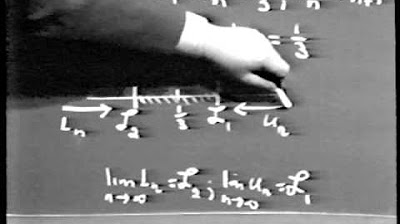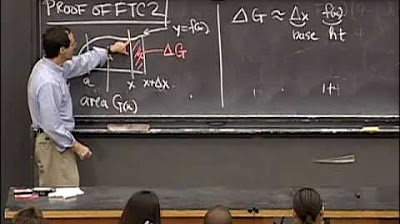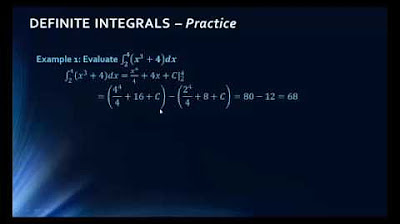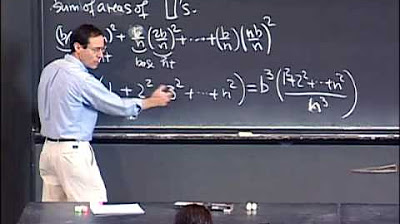Unit IV: Lec 2 | MIT Calculus Revisited: Single Variable Calculus
TLDRThis script from an MIT OpenCourseWare lecture explores the profound connection between differential and integral calculus. The professor delves into the motivation behind the invention of differential calculus, given the existence of integral calculus, and vice versa. Through the concept of area under a curve and the rate of change, the lecture illustrates the foundational theorems of integral calculus, highlighting the practicality and elegance of using antiderivatives to compute areas and the construction of functions from their derivatives.
Takeaways
- 📚 The script is a transcript from a lecture on the relationship between differential and integral calculus, part of MIT OpenCourseWare.
- 🕒 The professor discusses the logistics of time constraints and the decision to focus on integral calculus before differential calculus in the course.
- 🔄 The lecture aims to show the interplay between differential and integral calculus, highlighting the 'marriage' of the two branches of calculus.
- 📉 The concept of finding the rate of change of an area under a curve is introduced, which is analogous to the definition of the instantaneous rate of change in differential calculus.
- 📈 The idea of using the average rate of change to approximate the instantaneous rate of change is presented, leading to the definition of the derivative.
- 📚 The professor explains the use of basic axioms for area to derive the inequality that bounds the change in area ('delta A') and how it relates to the function 'f'.
- 🔑 The importance of the function 'f' being continuous is emphasized for the limit process to work correctly in finding the derivative.
- 🌟 The first fundamental theorem of integral calculus is introduced, relating the area under a curve to the inverse derivative of the function defining the curve.
- 📐 The concept of using antiderivatives to find areas is contrasted with the more laborious method of summing rectangles to find the area under a curve.
- 📝 The historical development of the notation for definite integrals is discussed, showing how it originally represented the limit of a sum but later came to represent the difference of antiderivatives.
- 🤔 The lecture addresses potential confusion about when and how to use antiderivatives to find areas, emphasizing the importance of understanding both methods.
Q & A
What is the main topic discussed in the lecture?
-The main topic discussed in the lecture is the relationship between differential and integral calculus, often referred to as 'The Marriage of Differential and Integral Calculus'.
Why does the professor suggest that the basic definitions of integral and differential calculus would be the same regardless of the order in which they are taught?
-The professor suggests that the basic definitions would be the same because the foundational concepts of both branches of calculus are inherently interconnected, and the definitions are built upon the same principles of limits and rates of change.
What is the motivation behind the professor's approach to teaching differential calculus after integral calculus?
-The motivation is to show the beautiful interplay between differential and integral calculus, and to demonstrate how one might have invented differential calculus if it had been motivated by the existing integral calculus.
What is the concept of 'area under a curve' in the context of this lecture?
-In the context of this lecture, 'area under a curve' refers to the process of finding the area between the curve defined by 'y = f(x)' and the x-axis, which is approached as the limit of a certain sum or an infinite series.
How does the professor relate the rate of change of an area under a curve to the height of the curve at a particular point?
-The professor relates the rate of change of the area under the curve to the height of the curve at a particular point by showing that the instantaneous rate of change of the area is equal to the value of the function at that point, which is the height of the curve.
What is the significance of the first fundamental theorem of integral calculus in the lecture?
-The first fundamental theorem of integral calculus is significant because it establishes a direct relationship between the area under a curve and the inverse derivative of the function defining the curve. It states that if a function 'G' is an antiderivative of 'f', then the area function 'A' is 'G(x)' plus a constant 'c'.
How does the professor explain the process of finding the area of a region without knowing the derivative of the function defining the region?
-The professor explains that even without knowing the derivative of the function, one can still find the area of a region by forming a limit of a sum of rectangles inscribed or circumscribed around the curve, which is a process that involves taking the limit as the number of rectangles approaches infinity.
What is the role of continuity in the derivation of the instantaneous rate of change of an area?
-Continuity plays a crucial role in the derivation as it ensures that as 'delta x' approaches 0, 'f(x1 + delta x)' approaches 'f(x1)', allowing the squeeze theorem to be applied and the limit of 'delta A/delta x' to be determined as 'f(x1)'.
Why does the professor emphasize the importance of understanding both the limit of a sum and the concept of an antiderivative?
-The professor emphasizes this because understanding both concepts allows students to compute areas under curves and their rates of change without relying on one method exclusively, thus providing a deeper understanding of calculus and its applications.
What is the historical context of the definite integral notation as discussed in the lecture?
-Historically, the definite integral notation was used to denote the limit of a sum, which is a more meaningful representation of the symbol. Over time, it has come to represent both the limit of a sum and the antiderivative of a function, which are numerically the same but conceptually different.
How does the professor illustrate the difficulty in applying the first fundamental theorem of integral calculus to a function whose antiderivative is not known?
-The professor uses the example of finding the area under the curve 'y = 1/x' from x = 1 to x = 2, where the antiderivative (a logarithmic function) is not known. This illustrates that while the area exists and can be computed as a limit, the first fundamental theorem cannot be applied without knowing the antiderivative.
What is the second fundamental theorem of integral calculus, and how does it relate to the first?
-The second fundamental theorem of integral calculus allows the construction of a function 'G' whose derivative is a given function 'f', by computing the definite integral of 'f'. It is the inverse of the first fundamental theorem, which provides a quick way to compute the area under a curve given the antiderivative.
Outlines
📚 Introduction to the Interplay of Differential and Integral Calculus
The professor introduces the concept of the interplay between differential and integral calculus, explaining the limitations of time and the decision to focus on integral calculus first. The lecture aims to demonstrate how differential calculus could have been developed from integral calculus, using the concept of the rate of change of an area under a curve as a motivating example. The fundamental axioms of area are also mentioned, setting the stage for the exploration of the relationship between these two branches of calculus.
📈 Derivation of the Instantaneous Rate of Change from Area Under a Curve
The speaker delves into the process of finding the rate at which the area under a curve changes at a specific point. By considering the area between 'x=a' and 'x=x1' and then allowing 'x1' to change by 'delta x', the change in area ('delta A') is examined. The instantaneous rate of change is defined as the limit of the average rate of change as 'delta x' approaches zero. The relationship between the area under the curve and the function's value at a point is established, leading to the first fundamental theorem of integral calculus.
🔍 The First Fundamental Theorem of Integral Calculus
The paragraph explains the first fundamental theorem of integral calculus, which connects the area under a curve to the inverse derivative of the function defining the curve. It is shown that if 'G' is a function whose derivative is 'f', then the area function 'A', which has 'f' as its derivative, must differ from 'G' by at most a constant. This leads to the conclusion that the area under the curve from 'a' to 'b' can be expressed as 'G(b) - G(a)', simplifying the process of finding areas using antiderivatives.
📘 Application of the First Fundamental Theorem to a Specific Problem
The professor applies the first fundamental theorem to a specific problem involving the area under the curve defined by 'y = sin(x)' from 'x = 0' to 'x = pi/2'. It is shown that by knowing the antiderivative of 'sin(x)', which is '-cos(x)', the area can be quickly calculated as '1'. This demonstrates the power of using antiderivatives to find areas, compared to the more laborious method of summing rectangles used in the previous lecture.
🤔 Reflecting on the Necessity of Understanding Limits of Sums
The speaker reflects on the importance of understanding the limit of sums as a foundational concept in calculus, even when easier methods using antiderivatives are available. A hypothetical scenario is presented where the area under the curve 'y = 1/x' from 'x = 1' to 'x = 2' is to be found. The difficulty arises when one does not know the antiderivative of '1/x', emphasizing the need to still understand how to compute areas as limits of sums even when antiderivatives are not readily known.
📌 Constructing the Antiderivative Function Explicitly
The paragraph discusses the process of constructing an antiderivative function 'G' explicitly when its derivative is known to be '1/x'. The idea is to define 'G' as the area under the curve from 'x = 1' to some 'x = x1', which can be computed as a limit of a sum. By doing so, 'G' is constructed such that its derivative is '1/x', illustrating the second fundamental theorem of calculus, which allows the construction of an antiderivative given the original function.
🌟 The Unity of Differential and Integral Calculus
The final paragraph wraps up the lecture by summarizing the unity between differential and integral calculus. The first fundamental theorem provided a quick way to compute areas using antiderivatives, while the second fundamental theorem allowed for the construction of an antiderivative given the original function. The lecture concludes by emphasizing the importance of understanding both methods and their relationship, highlighting the beauty of calculus in connecting these two branches.
📢 Call to Support MIT OpenCourseWare
The final note is a call to action for viewers to support MIT OpenCourseWare with a donation to ensure the continuation of free and open access to MIT courses. The support is acknowledged as crucial for the dissemination of high-quality educational resources.
Mindmap
Keywords
💡Creative Commons License
💡Differential Calculus
💡Integral Calculus
💡Rate of Change
💡Instantaneous Rate of Change
💡Continuity
💡First Fundamental Theorem of Integral Calculus
💡Antiderivative
💡Definite Integral
💡Second Fundamental Theorem of Integral Calculus
💡Natural Logarithm
Highlights
The lecture discusses the interplay between differential and integral calculus, highlighting the historical development and modern understanding of their relationship.
The concept of 'The Marriage of Differential and Integral Calculus' is introduced, emphasizing the inseparable connection between the two branches of calculus.
The motivation for the invention of differential calculus through the study of integral calculus is explored, providing a unique perspective on the development of calculus.
The area under a curve is defined as a limit of an infinite sum, illustrating the fundamental concept of integral calculus.
The rate of change of the area under a curve is related to the height of the curve at a given point, demonstrating a direct link between integral and differential calculus.
The definition of instantaneous rate of change is shown to be analogous to the average rate of change, leading to the concept of derivatives.
The use of the first fundamental theorem of integral calculus is explained, which connects the area under a curve to the inverse derivative of the curve's function.
The importance of continuity in the convergence of sequences to a common limit is discussed, a key aspect in the definition of derivatives.
The process of finding the area of a region without prior knowledge of derivatives is demonstrated through a historical approach to integral calculus.
The first fundamental theorem of integral calculus is applied to a specific problem involving the sine function, showcasing its practical use.
The distinction between the conceptual understanding and the computational process of integral calculus is highlighted, emphasizing the importance of both.
The historical notation of the definite integral is discussed, explaining its original purpose and its modern interpretation.
The second fundamental theorem of integral calculus is introduced, which allows for the construction of a function given its derivative.
The importance of being able to compute the area under a curve to construct the inverse derivative function is emphasized, a key concept in the second fundamental theorem.
The practical application of integral calculus in constructing logarithmic and trigonometric tables is mentioned, showing its relevance beyond academia.
The potential confusion between the limit of a sum and the area under a curve as represented by the definite integral is addressed, clarifying the two concepts.
The lecture concludes by emphasizing the beauty and difficulty of understanding the relationship between integral and differential calculus, encouraging further study.
Transcripts
Browse More Related Video

Unit IV: Lec 1 | MIT Calculus Revisited: Single Variable Calculus

Lec 20 | MIT 18.01 Single Variable Calculus, Fall 2007

Proof of fundamental theorem of calculus | AP Calculus AB | Khan Academy

Fundamental theorem of calculus (Part 1) | AP Calculus AB | Khan Academy

Math 1325 Lecture 13 2

Lec 18 | MIT 18.01 Single Variable Calculus, Fall 2007
5.0 / 5 (0 votes)
Thanks for rating: